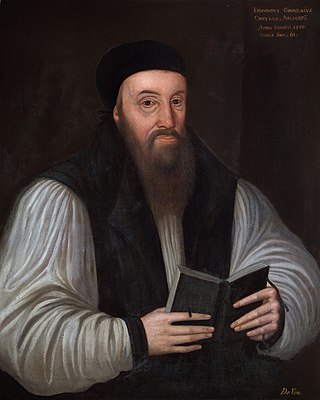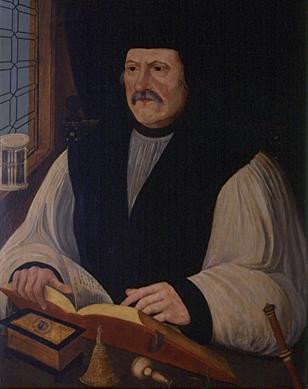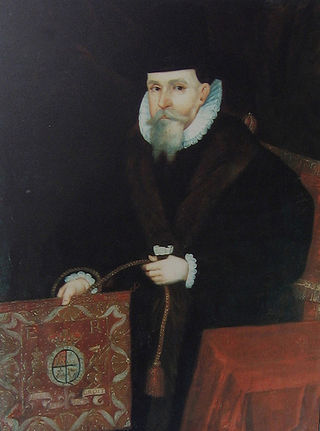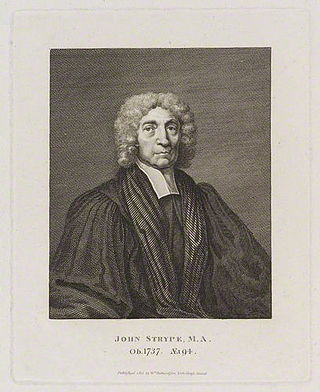Related Research Articles

Thomas Cranmer was a leader of the English Reformation and Archbishop of Canterbury during the reigns of Henry VIII, Edward VI and, for a short time, Mary I. He helped build the case for the annulment of Henry's marriage to Catherine of Aragon, which was one of the causes of the separation of the English Church from union with the Holy See. Along with Thomas Cromwell, he supported the principle of royal supremacy, in which the king was considered sovereign over the Church within his realm.

Edmund Grindal was Bishop of London, Archbishop of York, and Archbishop of Canterbury during the reign of Elizabeth I. Though born far from the centres of political and religious power, he had risen rapidly in the church during the reign of Edward VI, culminating in his nomination as Bishop of London. However, the death of the King prevented his taking up the post, and along with other Marian exiles, he was a supporter of Calvinist Puritanism. Grindal sought refuge in continental Europe during the reign of Mary I. Upon Elizabeth's accession, Grindal returned and resumed his rise in the church, culminating in his appointment to the highest office.

Matthew Parker was an English bishop. He was the Archbishop of Canterbury in the Church of England from 1559 to his death. He was also an influential theologian and arguably the co-founder of a distinctive tradition of Anglican theological thought.

Edmund Bonner was Bishop of London from 1539 to 1549 and again from 1553 to 1559. Initially an instrumental figure in the schism of Henry VIII from Rome, he was antagonised by the Protestant reforms introduced by the Duke of Somerset and reconciled himself to Catholicism. He became notorious as "Bloody Bonner" for his role in the persecution of heretics under the Catholic government of Mary I of England, and ended his life as a prisoner under Queen Elizabeth I.

Adam Loftus was Archbishop of Armagh, and later Dublin, and Lord Chancellor of Ireland from 1581. He was also the first Provost of Trinity College Dublin.

John Strype was an English clergyman, historian and biographer from London. He became a merchant when settling in Petticoat Lane. In his twenties, he became perpetual curate of Theydon Bois, Essex and later became curate of Leyton; this allowed him direct correspondence with several highly notable ecclesiastical figures of his time. He wrote extensively in his later years.

Richard Cox was an English clergyman, who was Dean of Westminster and Bishop of Ely.
Thomas Watson was a Catholic Bishop, notable among Catholics for his descriptions of the Protestant Reformation. Historian Albert Pollard described Watson as "one of the chief Catholic controversialists" of Mary Tudor's reign.

Hugh Boulter was the Church of Ireland Archbishop of Armagh, the Primate of All Ireland, from 1724 until his death. He also served as the chaplain to George I from 1719.

The Dean of St Patrick's Cathedral is the senior cleric of the Protestant St Patrick's Cathedral, Dublin, elected by the chapter of the cathedral. The office was created in 1219 or 1220, by one of several charters granted to the cathedral by Archbishop Henry de Loundres between 1218 and 1220.
The Anglican Archbishop of Armagh is the ecclesiastical head of the Church of Ireland, bearing the title Primate of All Ireland, the metropolitan of the Province of Armagh and the diocesan bishop of the Diocese of Armagh.
George Dowdall was a sixteenth-century Irish cleric, who was twice Archbishop of Armagh.
Events from the year 1553 in Ireland.

Christopher Hampton (1552–1625) was an Englishman who was the Church of Ireland Archbishop of Armagh from 1613 to 1625.
Thomas Lancaster was an English Protestant clergyman, Church of Ireland Archbishop of Armagh from 1568.
George Browne D.D. was an English Augustinian who was appointed by Henry VIII of England to the vacant Episcopal see of Dublin. He became the king's main instrument in his desire to establish the state church in the Kingdom of Ireland. An iconoclast, during the Protestant Reformation he is noted for destroying the Bachal Isu, one of the symbols of authority of the Archbishop of Armagh.
Michelangelo Florio (1515–1566), born in Florence, dead in Soglio, was the son of a Franciscan friar, before converting to Protestantism. He was a pastor in both England and Switzerland, and father of the renaissance humanist John Florio.
Edward Staples or Staple was an English born bishop of Meath.

Simon Haynes or Heynes was Dean of Exeter, Ambassador to France, and a signatory of the decree that invalidated the marriage of Henry VIII with Anne of Cleves. He became President of Queens' College at the University of Cambridge from 1529 to 1537, and toward the end of his life, was installed Canon of Windsor at Windsor Castle.
Roger Tonge otherwise Roger Tong or Tongue was an English clergyman who served as a chaplain to Edward VI and was later appointed dean of Winchester Cathedral in 1549.
References
 This article incorporates text from a publication now in the public domain : "Goodacre, Hugh". Dictionary of National Biography . London: Smith, Elder & Co. 1885–1900.
This article incorporates text from a publication now in the public domain : "Goodacre, Hugh". Dictionary of National Biography . London: Smith, Elder & Co. 1885–1900.- Strype, John Memorials of Thomas Cranmer, sometime Archbishop of Canterbury Oxford University Press 1840
- Sir James Ware Bishops of Ireland Dublin 1739